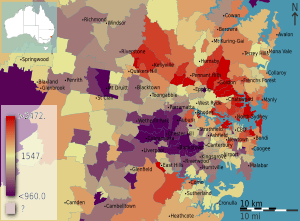Economy of Sydney facts for kids

The economy of Sydney is notable for its importance in the areas of trading, manufacturing, finance, education, and distribution in Australia. Sydney has the largest economy in Australia.
Sydney's CBD is the largest in Australia and also has plenty of surrounding commercial areas which are considered part of Sydney. A notable one is Parramatta, which is bigger than some state capitals.
Sydney city extends over the harbour bridge, forming North Sydney, a continuation of the CBD. North Sydney has a large economy; however it tends to have a high vacancy rate. Just a few kilometres north of Sydney's city centre, is Sydney's third largest commercial area , Chatswood. Chatswood's main economy is retail and is home to many highrise buildings, with its own recognisable skyline. 20th Century Fox has large Sydney studios.
History
Although the CBD dominated the city's business and cultural life in the early days, other business/cultural districts have developed in a radial pattern since World War II. In 1945, two-thirds of all jobs in Sydney were located in the City of Sydney and surrounding inner city municipalities, but post-war suburbanisation meant that only a quarter of the workforce were located in the City, South Sydney, Leichhardt and Marrickville municipalities.
With a boom in passenger railway construction came rapid extension of the suburbs along the railway corridors to the west and south, and eventually to the North Shore, after the completion of the Harbour Bridge allowed trains to continue from North Sydney into the CBD. This radial-spoke pattern of development changed after World War II, when increasing car ownership encouraged infill development where the railways didn't run, and then further expansion around the perimeter of the city. These outer areas have mostly missed out on further rail expansion and are primarily car dependent to this day.
Images for kids
-
The Sydney CBD is Australia's largest financial centre.


